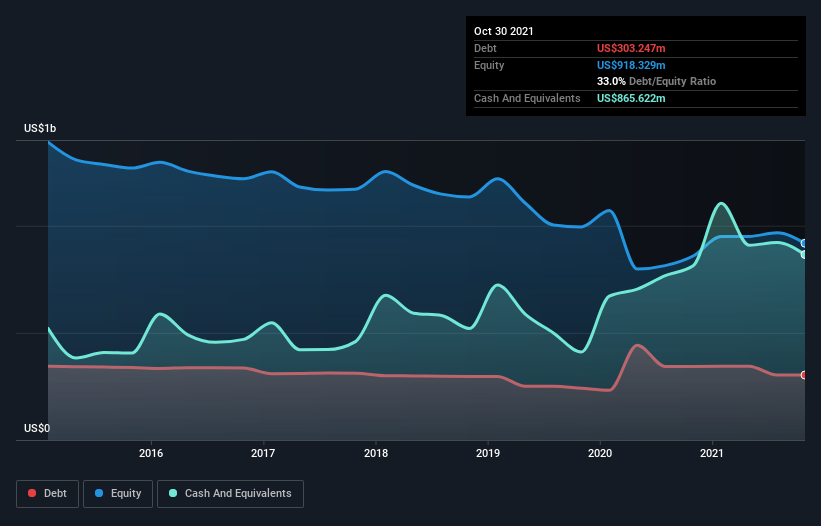We Think Abercrombie & Fitch (NYSE:ANF) Can Stay On Top Of Its Debt
Some say volatility, rather than debt, is the best way to think about risk as an investor, but Warren Buffett famously said that 'Volatility is far from synonymous with risk.' So it might be obvious that you need to consider debt, when you think about how risky any given stock is, because too much debt can sink a company. We note that Abercrombie & Fitch Co. (NYSE:ANF) does have debt on its balance sheet. But is this debt a concern to shareholders?
Why Does Debt Bring Risk?
Debt assists a business until the business has trouble paying it off, either with new capital or with free cash flow. If things get really bad, the lenders can take control of the business. However, a more usual (but still expensive) situation is where a company must dilute shareholders at a cheap share price simply to get debt under control. Having said that, the most common situation is where a company manages its debt reasonably well - and to its own advantage. The first thing to do when considering how much debt a business uses is to look at its cash and debt together.
Check out our latest analysis for Abercrombie & Fitch
How Much Debt Does Abercrombie & Fitch Carry?
As you can see below, Abercrombie & Fitch had US$303.2m of debt at October 2021, down from US$343.6m a year prior. But on the other hand it also has US$865.6m in cash, leading to a US$562.4m net cash position.
A Look At Abercrombie & Fitch's Liabilities
Zooming in on the latest balance sheet data, we can see that Abercrombie & Fitch had liabilities of US$1.03b due within 12 months and liabilities of US$1.16b due beyond that. On the other hand, it had cash of US$865.6m and US$83.4m worth of receivables due within a year. So its liabilities total US$1.25b more than the combination of its cash and short-term receivables.
This is a mountain of leverage relative to its market capitalization of US$1.94b. This suggests shareholders would be heavily diluted if the company needed to shore up its balance sheet in a hurry. Despite its noteworthy liabilities, Abercrombie & Fitch boasts net cash, so it's fair to say it does not have a heavy debt load!
Better yet, Abercrombie & Fitch grew its EBIT by 586% last year, which is an impressive improvement. If maintained that growth will make the debt even more manageable in the years ahead. There's no doubt that we learn most about debt from the balance sheet. But ultimately the future profitability of the business will decide if Abercrombie & Fitch can strengthen its balance sheet over time. So if you're focused on the future you can check out this free report showing analyst profit forecasts.
Finally, while the tax-man may adore accounting profits, lenders only accept cold hard cash. While Abercrombie & Fitch has net cash on its balance sheet, it's still worth taking a look at its ability to convert earnings before interest and tax (EBIT) to free cash flow, to help us understand how quickly it is building (or eroding) that cash balance. Happily for any shareholders, Abercrombie & Fitch actually produced more free cash flow than EBIT over the last three years. That sort of strong cash conversion gets us as excited as the crowd when the beat drops at a Daft Punk concert.
Summing up
Although Abercrombie & Fitch's balance sheet isn't particularly strong, due to the total liabilities, it is clearly positive to see that it has net cash of US$562.4m. And it impressed us with free cash flow of US$355m, being 132% of its EBIT. So is Abercrombie & Fitch's debt a risk? It doesn't seem so to us. There's no doubt that we learn most about debt from the balance sheet. However, not all investment risk resides within the balance sheet - far from it. For example, we've discovered 3 warning signs for Abercrombie & Fitch (1 is a bit unpleasant!) that you should be aware of before investing here.
Of course, if you're the type of investor who prefers buying stocks without the burden of debt, then don't hesitate to discover our exclusive list of net cash growth stocks, today.
Have feedback on this article? Concerned about the content? Get in touch with us directly. Alternatively, email editorial-team (at) simplywallst.com.
This article by Simply Wall St is general in nature. We provide commentary based on historical data and analyst forecasts only using an unbiased methodology and our articles are not intended to be financial advice. It does not constitute a recommendation to buy or sell any stock, and does not take account of your objectives, or your financial situation. We aim to bring you long-term focused analysis driven by fundamental data. Note that our analysis may not factor in the latest price-sensitive company announcements or qualitative material. Simply Wall St has no position in any stocks mentioned.

